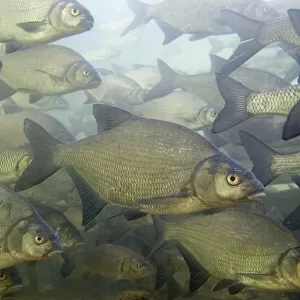Home > Science > Scientists
Radiant matter physics, 19th century
![]()

Wall Art and Photo Gifts from Science Photo Library
Radiant matter physics, 19th century
" Radiant matter" physics. 19th-century artwork of physicists carrying out experiments on what they called radiant matter. This was the cutting-edge physics of the day, with electric currents used to make gases glow in vacuum tubes (Geissler tubes), made possible by the development of an improved vacuum pump by Heinrich Geissler in around 1855 (this would later form the basis of neon lights). In 1859, Julius Plucker used a Geissler tube to observe cathode rays. From 1875, William Crookes developed the Crookes tube (far left, with Maltese Cross shadow). The glowing gases and cathode rays were explained by the discovery of the electron by J.J. Thomson in 1897, six years after this artwork appeared in Physique Populaire (E.Desbeaux, 1891)
Science Photo Library features Science and Medical images including photos and illustrations
Media ID 6467917
© SHEILA TERRY/SCIENCE PHOTO LIBRARY
1891 Cathode Ray Tube Crookes Tube Demonstrating Electrical Electricity Electron Electrons Experiment Experimenting History Of Science Particle Physics People Person Persons Physicist Physicists Researcher Researchers Researching Scientist Scientists Trio Tubes Vacuum Tube Laboratory Physical
FEATURES IN THESE COLLECTIONS
> Science
> Scientists
EDITORS COMMENTS
This 19th-century artwork captures the essence of radiant matter physics, a groundbreaking field that pushed the boundaries of scientific understanding during its time. In this vivid illustration, we witness a trio of dedicated physicists engrossed in their experiments on radiant matter. At the heart of these pioneering investigations lies the mesmerizing glow emanating from vacuum tubes known as Geissler tubes. These ingenious devices were made possible by Heinrich Geissler's revolutionary vacuum pump, developed around 1855 and later forming the basis for neon lights. By passing electric currents through these tubes, gases within would illuminate with an ethereal radiance. The leftmost figure represents William Crookes, who played a pivotal role in advancing this field with his invention of the Crookes tube. This remarkable apparatus is depicted casting a striking Maltese Cross shadow—a testament to Crookes' ingenuity and contribution to our understanding of cathode rays. It was not until J. J. Thomson's discovery of electrons in 1897—six years after this artwork graced Physique Populaire—that the glowing gases and enigmatic cathode rays observed here found their explanation. Thomson's groundbreaking work unveiled electron beams as fundamental particles, forever altering our comprehension of particle physics. As we gaze upon this historical masterpiece, we are transported back to an era where electricity met artistry and human curiosity propelled us towards new frontiers in science. It serves as a poignant reminder that even centuries ago, researchers tirelessly pursued knowledge and laid foundations for future breakthroughs that continue to shape our world today.
MADE IN THE USA
Safe Shipping with 30 Day Money Back Guarantee
FREE PERSONALISATION*
We are proud to offer a range of customisation features including Personalised Captions, Color Filters and Picture Zoom Tools
SECURE PAYMENTS
We happily accept a wide range of payment options so you can pay for the things you need in the way that is most convenient for you
* Options may vary by product and licensing agreement. Zoomed Pictures can be adjusted in the Cart.


